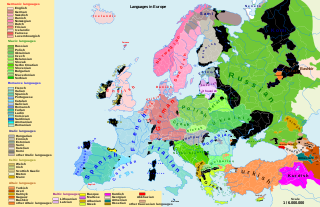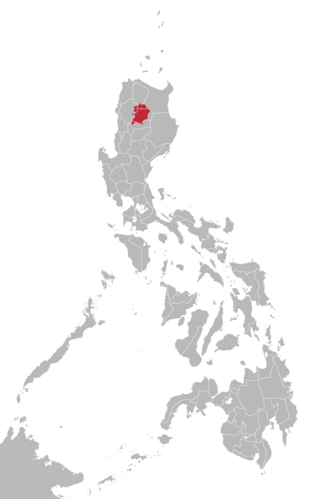Related Research Articles

There are over 250 languages indigenous to Europe, and most belong to the Indo-European language family. Out of a total European population of 744 million as of 2018, some 94% are native speakers of an Indo-European language. The three largest phyla of the Indo-European language family in Europe are Romance, Germanic, and Slavic; they have more than 200 million speakers each, and together account for close to 90% of Europeans.
Tukang Besi is an Austronesian language spoken in the Tukangbesi Islands in southeast Sulawesi in Indonesia by a quarter million speakers. A Tukang Besi pidgin is used in the area.
Nauruan Pidgin English is an English-based pidgin spoken in Nauru. It appears to be the result of a merger of Chinese-type and Melanesian-type pidgins. The language has also started to be superseded by English and currently has around 1,000-9,999 remaining speakers in 2007.
Cafundó, or Cupópia, is an argot spoken in the Brazilian village of Cafundó, São Paulo, now a suburb of Salto de Pirapora. The language is structurally similar to Portuguese, with many Bantu words in its lexicon.

Kalinga is a dialect continuum of Kalinga Province in the Philippines, spoken by the Kalinga people, alongside Ilocano. The Banao Itneg variety is not one of the neighboring Itneg languages.
Sissano is an Austronesian language spoken by at most a few hundred people around Sissano in West Aitape Rural LLG, Sandaun Province, Papua New Guinea. 4,800 speakers were reported in 1990, but the 1998 tsunami wiped out most of the population.
The Bangi language, or Bobangi, is a relative and main lexical source of Lingala spoken in central Africa. Dialects of the language are spoken on both sides of the Ubangi and the Congo rivers.
Krumen is a dialect continuum spoken by the Krumen people of Liberia and Ivory Coast. It is a branch of the Grebo languages, a subfamily of the Kru languages and ultimately of the Niger–Congo languages. It had 48,300 speakers in 1993. The main varieties are:

Maʼya is an Austronesian language of the Raja Ampat islands in Southwest Papua, Indonesia. It is part of the South Halmahera–West New Guinea (SHWNG) subgroup and is spoken by about 6,000 people in coastal villages on the islands Misool, Salawati, and Waigeo, on the boundary between Austronesian and Papuan languages.
Amba is a language spoken in parts of Uganda and the Democratic Republic of Congo by the Amba people. The Amba people call it Kwamba and it is known as Kihumu in the Democratic Republic of the Congo. Amba has a 70% lexical similarity with Bera. Dialects include Kyanzi (Kihyanzi) and Suwa (Kusuwa).
Kalabari is an Ijo language of Nigeria spoken in Rivers State and Bayelsa State by the Awome people. Its three dialects are mutually intelligible. The Kalabari dialect is one of the best-documented varieties of Ijo, and as such is frequently used as the prime example of Ijo in linguistic literature.
Duvle (Sikwari) is a Lakes Plain language of the Papua, Indonesia. It is spoken in Dagai village in Dagai District, Puncak Jaya Regency.
Kunda (Chikunda) is a Bantu language of Zimbabwe, with a some thousands of speakers in Zambia and Mozambique.
Kopkaka (Kopka) is an Ok language spoken in Seredala District, Yahukimo Regency, Highland Papua. The villages that speak this language are Seredala, Moruf, Mosomduba, Burupmakot, and others.
Sekar (Seka) is a dialect of Sekar Onim language, an Austronesian language of the Onin Peninsula in Bomberai, West Papua.
Lamaholot, also known as Solor or Solorese, is a Central Malayo-Polynesian dialect cluster of Flores, Indonesia. The varieties may not be all mutually intelligible; Keraf (1978) reports that there are 18 languages under the name.
Nefamese or Arunamese is a pidgin of Arunachal Pradesh, India. Its classification is unclear; Ethnologue states that it is based on the Assamese language, but also that it is most closely related to the Sino-Tibetan Gallong like the Assamese language formed out by the mixture of languages like Austroasiatic, Tibeto-Burman, Tai and Indo-European family of languages.
Uruangnirin is an Austronesian language spoken on the islands of Tarak and Faor in the Sebakor Bay, West Papua. Some Kalamang people from the neighboring island of Karas speak it as a second language. The languages most closely related to Uruangnirin are Onin and Sekar of the Bomberai Peninsula.
Ndyuka-Tiriyó Pidgin (Ndyuka-Trio) was a trade language used until the 1960s between speakers of Ndyuka, an English-based creole, and Tiriyó and Wayana, both Cariban languages.
References
- ↑ Onin at Ethnologue (18th ed., 2015) (subscription required)
- ↑ "Onin Based Pidgin". Ethnologue. Archived from the original on 2019-06-06. Retrieved 2025-01-14.
- ↑ "Sekar-Onim". Peta Bahasa (in Indonesian). Retrieved 2024-03-19.
- ↑ Pidgin Onin at Ethnologue (18th ed., 2015) (subscription required)
- ↑ "OLAC resources".